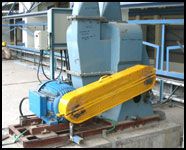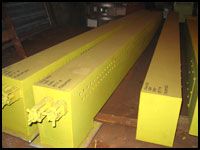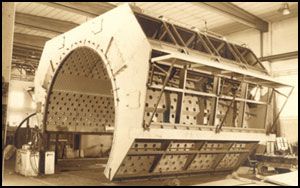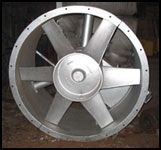
WIRE PART VACUUM SYSTEM
In the wire part of a paper machine, different levels of vacuum need to be created in different applications for effective drainage of water from the stock. We have a wide range of robust high pressure fans specially designed for such application. Power consumption of such fans are much lower compared to conventional vacuum pumps. The fans are of single stage or double stage design depending upon the duty conditions. The fan impellers are made of stainless steel and the casings are of either stainless steel or mild steel lined with FRP. The system comprises of : Connection ducting from vacuum box Water eliminator Centrifugal fan with accessories Discharge duct from fan outlet
...more
Wet End Ventilation System
GENERALPaper machine wet end produces maximum heat from various motors and also generates huge amount of moisture as "free evaporation" from stock on the wire part. Another major source of moisture is water mist generated inside and under the wire. Thus, Wet end is a very important part of the paper machine when the machine hall air -flow dimensioning is considered. The importance of wet end ventilation system is not normally recognized and the consequences can be very serious resulting in quality/ production losses due to condensate dripping and fast deterioration of machinery and building structures. DESCRIPTIONSonar-DNB wet end ventilation system is based on knowledge & experience of different paper machine wet end applications and theoretical calculations of evaporation and air movements of moving fabrics. We had designed various kinds of configurations of wire exhaust systems for different types of paper and board machines. The wet end ventilation system consists of the following components: wire exhaust air headers located inside/outside the wire loops exhaust ducting for wire pits water eliminators, equipped with continuous washing devices if necessary exhaust air fan(s) connected to the air ducting exhaust air ducting to the atmosphere general exhaust system for wire and press sections which removes moist air from drive side of paper machine. This system prevents the moist air movements towards working areas etc.
...more
Pocket Ventilation System
Provides a controlled drying environment by keeping low and uniform humidity level in cylinder pockets. Improves moisture profile across the paper web. Increases Drying Capacity from 5 to 15 % depending upon Machine configuration, type of paper, GSM etc. Increases the temperature inside Hood and thereby helps further in preventing condensation inside the Hood. Overdrying of paper at the edges can be controlled by edge correction dampers of PV box. Improves the life of Dryer screens and felt rolls.
...more
High Velocity Hood
GENERALHigh Efficiency Hood (or High Velocity Hood) is provided over MG cylinder in a combined M/c or on a Yankee M/c. When it is provided on a Yankee cylinder, it is also called a Yankee Hood.Yankee cylinders are primarily used in the production of tissue and towel. On tissue machine most of the drying is effected on the Yankee cylinder. After the wire section, the paper is pressed against the Yankee cylinder surface. When the paper is dry, it is doctored off the cylinder surface, in other words, crêped. The Tissue-Yankee hoods are today equipped with extremely high speed blowing nozzles as well as highest possible air temperatures. In the production of board, the Yankee cylinder is used to give glazing polish to the board. The drying intensity of board machine Yankee hoods is usually not very high because of quality reasons, but the latest board hoods are being designed for high air temperatures.Depending on the requirement of air impingement temperature, the heating medium for heating the recirculated air can be: (a) Steam (for air temperature upto 150 to 160°C)(b) Thermic fluid (for air temperature upto 200°C )(c) Gas or Oil (for air temperature upto 450°C)DRYING PROCESSThe drying system that consists of MG cylinder and MG hood is an arrangement that combines two methods of heat energy transfer. On one side, heat is transferred from the cylinder to the web by conduction, while simultaneously, on the other side, energy is transferred from the hood to the web by convection. Consequently, the hood and the cylinder have to be considered as a combined system. The following factors have the most effect on the drying efficiency: 1. MG cylinder steam pressure and heat transfer coefficient2. Hood impingement air velocity3. Hood impingement air temperature and humidity 4. Hood nozzle geometry 5. Distance between the hood and the cylinder surfaceDESCRIPTIONThe Schematic arrangement of Centralized steam-heated MG Hood is enclosed. The hood is installed on top of the MG cylinder in two Sections - Section 1 and Section 2. Hot air is supplied through two recirculating fans (Item nos.1 ) and then through two heaters (Item Nos. 3 ) into the blow boxes of the hood. The hot air is utilised in evaporating moisture in the paper.The moisture laden air is sucked out of the hood through return air pipes provided in the blow boxes and then through a common air duct provided in each section of the hood. The return air from each section is then led to a common plenum box. On either side of the common plenum box there is a wire-mesh filter box (Item No.6) with wire-mesh filter (Item No. 4) for filtering the re-circulating air. A portion of the moisture laden return air from Wet Section of common plenum box is bleeded out of the System through the exhaust fan (Item no.2 ) via a Heat Recovery Unit (Item no. 5). The remaining Portion of return air from each section is recirculated into the system through recirculating fans and then through the heaters as stated before. The fresh air (or make up air as it is called) is filtered in Fresh Air Filters (Item No.7) and is preheated in the Heat Recovery Unit by utilising the heat from the exhaust air. The heated fresh air is then led into the common plenum box. Manually operated Multi- Vane Control Dampers (Item Nos. 8) are provided before the Recirculation Fans to adjust the impingement air and a butterfly damper (Item No.9) is provided before the Exhaust air Fan to adjust the Hood Exhaust Air and also to adjust the fresh air supply. CONSTRUCTIONAL DETAILSThe hood is constructed out of sturdy MS plate on the drive and operating sides. The Upper and side portion of the hood is covered with insulated panels which are made from steel frame and outer Aluminium sheets filled with resin bonded mineral wool insulation. Two supply air openings are provided in the hood which are connected to the blow boxes. The blow box is made in segments. It is made of perforated cold roll sheet of 2 mm thick and is complete with return air pipes which serve as a passage of the return air. The hot air is impinged on the paper over the MG Cylinder through the perforated holes in the blow box. The return air alongwith the moisture evaporated is sucked out of the hood through two return air openings provided in the hood .The supporting structures of the HV Hood are of MS painted with primer paint (not included in our scope).Inspection openings with easily removable covers are provided for removing fine paper fluffs which may get accumulated during operation.Necessary sealing arrangement between MG Cylinder and Hood is provided to prevent ingress of cold Air into the Hood. RETRACTION ARRANGEMENTThe Hood is made in two halves, each of them is provided with CI Wheels on either side which can slide on a support rail. These halves can, with the aid of Pneumatic cylinders, be moved from the MG Cylinder to improve the possibility to clean and inspect the space between the Hood and the Cylinder.The Hood can be retracted by 200 mm on each side. The total gap between the two halves when fully retracted is 400 mm. To take care of the Retraction suitable Flexible connections are provided in the external Supply and Exhaust air ducting connected to the Hood.
...more
Heat Recovery Machines
The drying plants in the paper industry require lot of heat energy. It is therefore necessary first to see that drying process is as economical as possible. An optimized heat recovery system directly reduces the prime heat consumption.The most common dryer types in paper industry are the multi-cylinder machine, the Yankee machine and Air Dryers.HEAT RECOVERY- MULTI-CYLINDER MACHINES The superheat of exhaust air from a PM Hood is often in the range of 15 to 20°C, i.e. the dry bulb temperature of the exhaust air is 15 to 20°C higher than the dew point. This, however, depends on the temperature of make-up air, the quantity of infiltration air and the steam pressure in the cylinders.The supply air to the hood is heated in a heat recovery plant to an economically optimum temperature which is around 50 to 60°C and this can be attained by an air / air heat exchanger.The table below shows approx heat consumptions obtained in a multi-cylinder machine provided with heat recovery. Here an open hood with dew point 40°C is compared to a closed hood with dew point of 53°C and 58°C HEAT RECOVERY The drying plants in the paper industry require lot of heat energy. It is therefore necessary first to see that drying process is as economical as possible. An optimized heat recovery system directly reduces the prime heat consumption.The most common dryer types in paper industry are the multi-cylinder machine, the Yankee machine and Air Dryers.The superheat of exhaust air from a PM Hood is often in the range of 15 to 20°C, i.e. the dry bulb temperature of the exhaust air is 15 to 20°C higher than the dew point. This, however, depends on the temperature of make-up air, the quantity of infiltration air and the steam pressure in the cylinders.The supply air to the hood is heated in a heat recovery plant to an economically optimum temperature which is around 50 to 60°C and this can be attained by an air / air heat exchanger.The table below shows approx heat consumptions obtained in a multi-cylinder machine provided with heat recovery. Here an open hood with dew point 40°C is compared to a closed hood with dew point of 53°C and 58°C HEAT RECOVERY - HIGH EFFICIENCY HOOD Yankee hoods may be steam -heated by means of steam coils or may be gas or oil heated in the air circulation unit. In the former case, the air impingement temperature lies in the range of 140°C to 160°C and in the latter case, the drying temperature can be as high as 350°C to 450°C.For this system a well designed heat recovery unit is essential to recover a part of the exhaust heat in pre-heating the fresh air intake to the hood.TYPES OF AIR TO AIR HEAT RECOVERY UNITSTwo types of air to air heat exchangers are commonly used -Channel design and tube design. This cross-flow heat exchanger ; has no moving parts is easy to adapt to different flows and temperature efficiencies is available for high temperatures and corrosive atmospheres
...more
Totally Enclosed Hood & Air System
The closed PM hoods, encasing entire paper machines are designed to satisfy the demand of high dew point operation, thereby achieving an efficient, uniform and economical paper web drying.During the drying process a large quantity of moisture is evaporated from the paper web. This moisture is discharged to the atmosphere through Hood exhaust fans. Part of the heat carried along with the exhaust air is recovered in pre-heating the Hood Make-up air in Heat Recovery Units.The make-up air, thus pre-heated, is further heated in water-air and steam -air heat exchangers and introduced in the paper machine through various blow boxes via centrifugal supply air fan and ducting.
...more
air system components
AIR SYSTEM COMPONENTS During the past three decades Sonar-DNB group have developed paper machine air system components which are energy efficient, long lasting, easy to operate and easy to maintain. The paper industry requires reliable and affordable components with low operating costs, and these requirements have been met by Sonar-DNB Systems. The components designed by Sonar-DNB are well suited and especially built for respective processes.These components are also suitable for similar applications in various other industrie The range of components developed and marketed by Sonar-DNB group include: Axial flow fans for all types of application Centrifugal fans including ID Fan, FD Fan & Primary Air fan for Boilers. Dampers - Guide vane control dampers, multi-louvre dampers, butterfly dampers, sectionalized & edge correction dampers for blow boxes. Air Filters of various types & sizes suitable for varied process conditions Flexible connections - standard and also suitable for high temperature applications Cyclone collectors Water eliminators Steam-Air Heat Exchangers Water-Air Heat Exchangers Thermic Oil-Air Heat Exchangers Air -Air Heat Exchangers Insulated panels Insulated doors Fabricated items of mild steel, stainless steel, galvanized steel and aluminum.
...moreBe first to Rate
Rate ThisOpening Hours